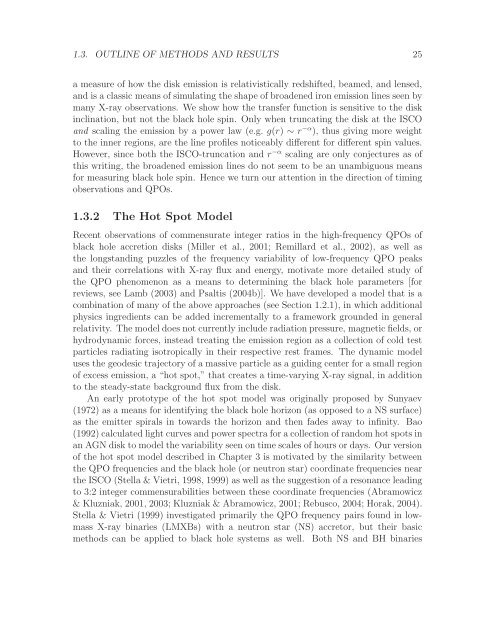Radiation Transport Around Kerr Black Holes Jeremy David ...
Radiation Transport Around Kerr Black Holes Jeremy David ...
Radiation Transport Around Kerr Black Holes Jeremy David ...
Create successful ePaper yourself
Turn your PDF publications into a flip-book with our unique Google optimized e-Paper software.
1.3. OUTLINE OF METHODS AND RESULTS 25<br />
a measure of how the disk emission is relativistically redshifted, beamed, and lensed,<br />
and is a classic means of simulating the shape of broadened iron emission lines seen by<br />
many X-ray observations. We show how the transfer function is sensitive to the disk<br />
inclination, but not the black hole spin. Only when truncating the disk at the ISCO<br />
and scaling the emission by a power law (e.g. g(r) ∼ r −α ), thus giving more weight<br />
to the inner regions, are the line profiles noticeably different for different spin values.<br />
However, since both the ISCO-truncation and r −α scaling are only conjectures as of<br />
this writing, the broadened emission lines do not seem to be an unambiguous means<br />
for measuring black hole spin. Hence we turn our attention in the direction of timing<br />
observations and QPOs.<br />
1.3.2 The Hot Spot Model<br />
Recent observations of commensurate integer ratios in the high-frequency QPOs of<br />
black hole accretion disks (Miller et al., 2001; Remillard et al., 2002), as well as<br />
the longstanding puzzles of the frequency variability of low-frequency QPO peaks<br />
and their correlations with X-ray flux and energy, motivate more detailed study of<br />
the QPO phenomenon as a means to determining the black hole parameters [for<br />
reviews, see Lamb (2003) and Psaltis (2004b)]. We have developed a model that is a<br />
combination of many of the above approaches (see Section 1.2.1), in which additional<br />
physics ingredients can be added incrementally to a framework grounded in general<br />
relativity. The model does not currently include radiation pressure, magnetic fields, or<br />
hydrodynamic forces, instead treating the emission region as a collection of cold test<br />
particles radiating isotropically in their respective rest frames. The dynamic model<br />
uses the geodesic trajectory of a massive particle as a guiding center for a small region<br />
of excess emission, a “hot spot,” that creates a time-varying X-ray signal, in addition<br />
to the steady-state background flux from the disk.<br />
An early prototype of the hot spot model was originally proposed by Sunyaev<br />
(1972) as a means for identifying the black hole horizon (as opposed to a NS surface)<br />
as the emitter spirals in towards the horizon and then fades away to infinity. Bao<br />
(1992) calculated light curves and power spectra for a collection of random hot spots in<br />
an AGN disk to model the variability seen on time scales of hours or days. Our version<br />
of the hot spot model described in Chapter 3 is motivated by the similarity between<br />
the QPO frequencies and the black hole (or neutron star) coordinate frequencies near<br />
the ISCO (Stella & Vietri, 1998, 1999) as well as the suggestion of a resonance leading<br />
to 3:2 integer commensurabilities between these coordinate frequencies (Abramowicz<br />
& Kluzniak, 2001, 2003; Kluzniak & Abramowicz, 2001; Rebusco, 2004; Horak, 2004).<br />
Stella & Vietri (1999) investigated primarily the QPO frequency pairs found in lowmass<br />
X-ray binaries (LMXBs) with a neutron star (NS) accretor, but their basic<br />
methods can be applied to black hole systems as well. Both NS and BH binaries
















